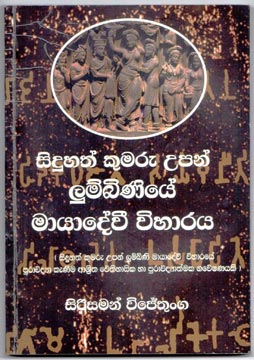Book
REVIEW
New revelations on Buddha’s birth
Book - Siduhath Kumaru
Upan Lumbiniye Mayadevi Viharaya
Author: Sirisaman Wijetunga
Reviewed by Rohana Ariyaratna
The Buddha’s Birth and the place where he was born and all other
details connected to the hallowed event is significant to Buddhists all
over the world. According to Buddhist tradition Queen Maya gave birth to
Prince Siddhartha, holding on to a branch of a Sal tree in the Lumbini
garden or park (in present day Nepal), midway between the kingdoms of
her husband, King Suddodana and her parents.
There have been various different viewpoints and opinions presented
by many historians and scholars regarding the birth and other important
events of the life of the Buddha. Whatever views presented should be
verified and proved with evidence and facts gathered from archaeological
excavations.
The latest archaeological foray into the birth of the Buddha and the
place was initiated by Professor Robin Coningham of Durham University,
England.
 A
prolific writer on historical and archaeological events, Sirisaman
Wijetunga in his latest publication entitled ‘Siduhath Kumaru Upan
Lumbiniye Mayadevi Viharaya’ deals mainly with Professor Coningham’s new
discoveries in the Mayadevi Temple and how those details have changed
present scholarly views regarding the birth and the place where the
Buddha was born. A
prolific writer on historical and archaeological events, Sirisaman
Wijetunga in his latest publication entitled ‘Siduhath Kumaru Upan
Lumbiniye Mayadevi Viharaya’ deals mainly with Professor Coningham’s new
discoveries in the Mayadevi Temple and how those details have changed
present scholarly views regarding the birth and the place where the
Buddha was born.
Buddhist traditions
Wijetunga’s latest publication is important to those who read only
Sinhala publications because this book is a great source to expand their
limited knowledge of this important event other than what Buddhist
traditions and oral and textual sources had taught them earlier.
In addition to what Professor Coningham discovered, Wijetunga has
given a detailed description of Emperor Asoka and his propagation of
Buddhism, political and sociological details of Jambudipa [India], how
Buddhist literary works had depicted the Buddha’s birth and also the
Lumbini Garden where he was born. His close association with history and
archaeology has enabled him to enrich the Sinhala readers with a
plethora of publications—books and a series of newspaper articles—about
the heritage linked to Buddhism. His service and the experience he
gained as an associate director in the Archaeology Department and also
in several other institutions pertaining to the field of history and
archaeology, has turned him into a specialist and an important
personality in these particular fields.
Lumbini is one of the key sites associated with the life of the
Buddha and was rediscovered in 1896 when it was identified as the
birthplace of the Sacred One. According to the rock edict documenting
the visit of Emperor Asoka to the site of the Buddha’s birth and other
evidence revealed from the earlier excavations, the sacred event is said
to have occurred in the 3rd century B.C.
But the latest excavations directed by Robin Coningham and Kosh
Prasad Acharya in the Mayadevi Temple premises, revealed older timber
structures lying beneath the walls of the later brick shrine. According
to Coningham the layout of the more recent shrine duplicates the layout
of the earlier wooden structures pointing to a continuity of Buddhist
worship at the site.
Historic details
The exact date of the Buddha’s birth is disputed with Nepalese
authorities accepting 623 B.C. and others favouring more recent dates
around 400 B.C. But the discovery of a timber structures buried within
the temple and also parts of a tree supposed to be the tree that Queen
Maya grasped while delivering the child Siddartha, has given a new
meaning to the existing views.
The discovery contributes to a better understanding of the early
development of Buddhism, the early life of the Buddha and also the
spiritual significance of Lumbini. The most important fact is that these
excavations at the Mayadevi Temple reveal that the Buddha could have
been living more than a century earlier than the dates accepted by many
scholars.
The new developments seem to have prompted Wijetunga to bring out a
well researched and well compiled treatise. Professor Leelananda
Prematilake in one of the prefaces states that Wijetunga’s attempt to
present details of Coningham’s significant discoveries and the historic
details of Buddhism in India and the major events in the life of the
Buddha, should be commended as it helps and guides interested Sinhala
readers to get a better understanding of this hallowed event as well as
the historical and archaeological value of our Buddhist heritage.
In addition to the excavations in Mayadevi Temple Wijetunga also adds
a special chapter describing the valuable and courageous contributions
of Anagarika Dharmapala in rescuing Buddhagaya, a religious site
important to Buddhist followers.
Wijetunga’s latest publication is a valuable and significant
contribution to readers and scholars interested in the traditions and
the history of Buddhism. |

